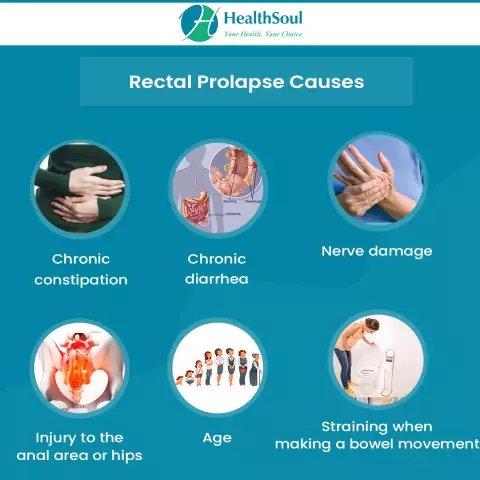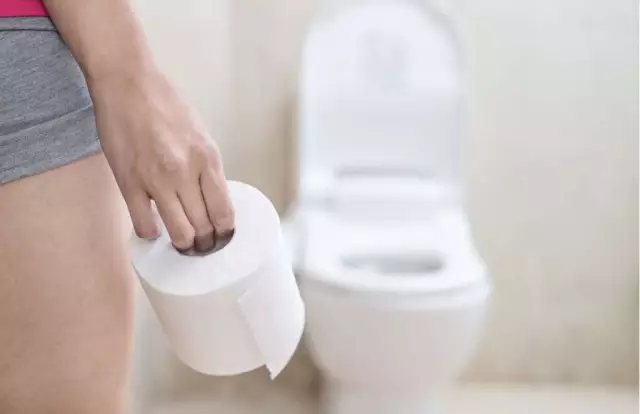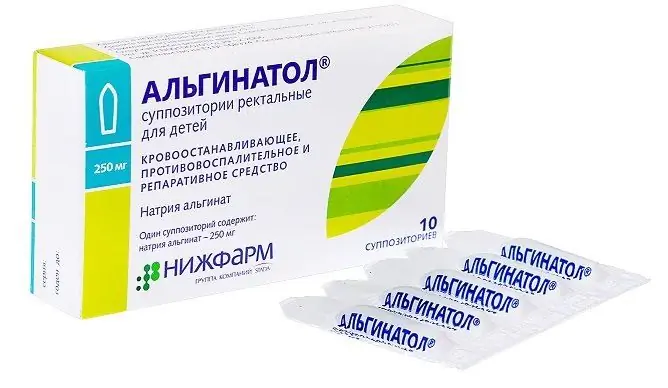- Author Rachel Wainwright [email protected].
- Public 2023-12-15 07:39.
- Last modified 2025-11-02 20:14.
Prolapse of hemorrhoids: treatment, how to correct yourself
The content of the article:
- When and how does hemorrhoids prolapse
- A hemorrhoid has fallen out, what should I do?
-
Treatment of prolapse of hemorrhoids
- Ligation with latex rings
- Suture ligation
- Photocoagulation, or laser coagulation
- Sclerotherapy
- Surgical removal of hemorrhoids
- Diagnosis of hemorrhoids
- Video
The prolapse of hemorrhoids indicates the progression of hemorrhoids. This is a common proctological disease in which there is a pathological expansion and inflammation of the veins of the rectum with the formation of nodes.

The prolapse of hemorrhoids begins with the second stage of hemorrhoids
When and how does hemorrhoids prolapse
Initially, the patient discovers that the nodes fall out of the anal canal during bowel movements, as well as with significant physical exertion or a sharp increase in intra-abdominal pressure with a strong cough or sneeze. During this period, the knots that have dropped out are adjusted independently. As the pathology progresses, for their loss, it becomes quite insignificant physical activity, and their independent reduction no longer occurs, but it turns out to be manually adjusted. If treatment is not carried out and the disease develops further, the hemorrhoids are constantly in a prolapsed state, and it is no longer possible to correct them on their own.
Based on the loss of nodes, four stages of hemorrhoids are distinguished:
- The nodes do not fall out of the rectum.
- The nodes fall out from time to time, but they adjust on their own.
- Knots fall out often, do not adjust on their own, but they can be adjusted manually.
- The nodes can not be adjusted either independently or manually, they are constantly in a dropped state.
After looking at the photo of the prolapse of hemorrhoids, you can get acquainted with how they look at different stages of the disease.

Loss of nodes serves as a diagnostic sign for determining the stage of hemorrhoids
Determination of the stage is important for the development of treatment tactics. If at stages I and II, conservative treatment is usually sufficient, then at stage III, surgical intervention may be necessary, treatment of hemorrhoids at stage IV is possible only by surgery.
Dropped knots create significant discomfort. Often, edematous, inflamed nodes fall out, which may have a cyanotic hue, indicating a violation of blood circulation in them.
The cause of prolapse is an increase in the pathological process, weakening of the walls of hemorrhoidal veins and stagnation of blood in them in the absence of therapy or with improper treatment of hemorrhoids. Predisposing factors are: loss of tone of the anal sphincter, atrophy of rectal tissue, increased intra-abdominal pressure, chronic constipation or, on the contrary, diarrhea, the habit of sitting on the toilet for a long time, systematic lifting of weights, a sedentary lifestyle.
A hemorrhoid has fallen out, what should I do?
The fallen node should be tried to correct, that is, return to the rectum. Before starting the reduction, you should wash your hands and the perianal area, you can put on a disposable medical glove on the hand that will be reduced. Usually the procedure is painless, but with a low pain threshold, you can anesthetize the anal area with an anesthetic in the form of an ointment or gel (Lidocaine ointment, EMLA). A number of anti-hemorrhoids ointments have an analgesic effect (Procto-Glivenol, Proctosan, Aurobin), you can use them.
The patient takes a comfortable position (you can lie down or squat down), with one hand the buttock is pulled to the side, the anus with the finger of the other hand and the dropped nodes are lubricated with petroleum jelly or ointment. Then you should relax the anal sphincter, carefully push the hemorrhoidal node into the anal canal, and then squeeze the sphincter tightly. After the procedure, you should take a horizontal position for 20-30 minutes.
Treatment of prolapse of hemorrhoids
Manual reduction of hemorrhoids is not a radical treatment. This is a temporary measure to eliminate discomfort, as well as to prevent possible pinching of a dropped knot.
Treatment of hemorrhoids in the early stages consists of drug therapy in combination with lifestyle correction. Regular, but not excessive physical activity, balanced nutrition, giving up bad habits, avoiding stress is recommended.
Medication therapy for hemorrhoids consists mainly in the use of topical drugs (anti-inflammatory, venotonic, analgesic, hemostatic drugs in the form of suppositories, ointments). If necessary, drugs of general action are prescribed (phlebotropic, analgesic, anti-inflammatory, etc.). The main therapy can be supplemented with compresses, lotions, sitz baths with decoctions of medicinal herbs and other medicinal substances. Hemorrhoids respond well to conservative treatment if it is started in a timely manner.
Complete removal of hemorrhoids is performed using invasive methods.
Minimally invasive methods include ligation with latex rings, suture ligation, photocoagulation, sclerotherapy.
Ligation with latex rings
The method is effective at stage II-III of internal hemorrhoids; mixed hemorrhoids are also indicated for it in the case of a clear differentiation of internal and external nodes. The essence of the method lies in the fact that the hemorrhoidal node is pinched by a hypoallergenic latex ring, after which blood circulation is disturbed in it, it dies, and after a while it is independently rejected and removed from the anus during defecation.

One of the effective methods of removing hemorrhoids is laser coagulation
Suture ligation
Suture ligation involves suturing the blood vessels that provide blood flow to the hemorrhoids. This procedure is carried out using an anoscope under ultrasound control. As well as latex, suture ligation is effective in stages II and III, and can be used for mixed hemorrhoids.
Photocoagulation, or laser coagulation
The method consists in exposing hemorrhoids to a directed beam of light with a certain wavelength. It is usually used when it is impossible to ligate hemorrhoids for one reason or another. The advantages are no bleeding, no risk of infection, painlessness.
Sclerotherapy
The method consists in introducing a special substance (sclerosant) into the blood vessels that feed the hemorrhoids, which blocks the vessel, causing its walls to stick together. This method is especially effective for hemorrhoidal bleeding.
Surgical removal of hemorrhoids
At stage IV, and sometimes, when the use of minimally invasive methods for one reason or another is impossible, then at stage III, they resort to the removal of hemorrhoids using surgery. The operation according to the Longo method is more often used, since it allows not only to remove the nodes, but also to tighten the weakened mucous membrane of the rectum.
During the Longo operation, a part of the rectal mucosa is removed above the hemorrhoidal node, after which the defect is sutured, the mucous membrane is pulled up, which leads to a decrease in the blood supply to the hemorrhoid, it decreases, collapses, then becomes overgrown with connective tissue.
At stage IV, the method of classical hemorrhoidectomy with subsequent rehabilitation can be applied.
Diagnosis of hemorrhoids
Hemorrhoids can be external or internal. With external hemorrhoids, the patient can palpate the nodes around the anus; internal hemorrhoids can be detected on their own by the prolapsed hemorrhoids. The fact is that in the early stages, hemorrhoids may not have pronounced clinical manifestations. In some cases, the disease is detected at an early stage during a medical examination for another reason.
The main symptoms of hemorrhoids: discomfort in the anal area, itching, burning, pain during and after bowel movements, bleeding from the lower intestine (usually during bowel movements, the patient notices bloody discharge on toilet paper, in feces), a foreign body sensation in the anus … Severe pain in the anal region may indicate an infringement of the prolapsed hemorrhoids by the anal sphincter.
Hemorrhoids are diagnosed by the following methods:
- digital rectal examination;
- anoscopy or sigmoidoscopy;
- analysis of feces for occult blood;
- a blood test (in order to identify possible anemia).
Video
We offer for viewing a video on the topic of the article.

Anna Aksenova Medical journalist About the author
Education: 2004-2007 "First Kiev Medical College" specialty "Laboratory Diagnostics".
Found a mistake in the text? Select it and press Ctrl + Enter.






